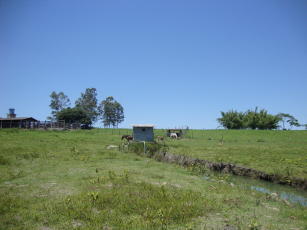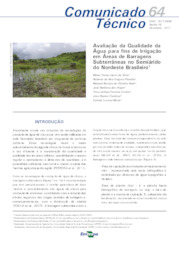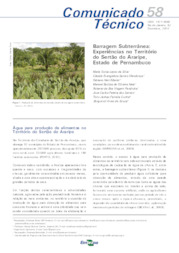Barragem subterrânea
Underground dam

Photo: FAÉ, Veramilles Aparecida
The underground dam is a technology to capture and store rainwater for food production. It has been implemented by farmers in the Brazilian semiarid region and now contributes not only to family agricultural production but also reduces the risks of rain-dependent agriculture. Its function is to retain rainwater that flows on and into the ground, through an impermeable wall built inside the soil that rises to a height of about 50 centimeters above the surface, in the opposite direction of the water descent. The underground dam forms a temporary artificial ebb in which the land remains wet for a period of two to five months after the rainy season, which allows cropping even in the dry season. Its construction is carried out by digging a ditch that crosscuts the water descent to the rock or to the impermeable layer. Inside the ditch, a 200-microns-thick polyethylene plastic is spread over the dam's entire length, and then it is closed with the earth that was removed at its opening. In this wall, a spillway must be made to eliminate excess water when there are torrential rains. The cultivation options depend on the economic and social interest of each region and family. It is recommended to build the dam in areas whose soils are 1.5 to 4.5 meters deep, have a gentle slope of 0.4% to 2.0%, form abutments (shallow ends), are not saline, and have sandy to medium texture. The cost of an underground dam varies depending on local conditions. The Underground Dam is a technology of inclusion, as it allows the farmer to reach greater success in the cultivation of various species, which improves the living conditions of rural families and ensures income and food security. In 2008, this technology was highlighted in Embrapa's Social Report and, in 2013, it was recognized as a social technology by the Banco do Brasil Foundation. In addition, it is in line with the Sustainable Development Goals (SDGs) and, in 2018, it was among the finalist initiatives of the Prêmio ODS Brasil (Brazil's SDG Awards), in the category "Teaching, Research and Extension".
Where to find:
Embrapa Semiárido - Rodovia BR 428 - Km 152, CEP: 56302-970 - Caixa Postal: 23 – Petrolina-PE – Tel. 87-3866-3600 – Fax: 87-3866-3815.
Embrapa Solos - Rua Jardim Botânico, 1.024 - Jardim Botânico - Rio de Janeiro, RJ - Brasil - CEP 22460-000 - Tel.: (021) 2179 4500
Publicações nos links:
https://ainfo.cnptia.embrapa.br/digital/bitstream/CPATSA/6836/1/BPD36.pdf
https://ainfo.cnptia.embrapa.br/digital/bitstream/item/54893/1/INT96.pdf
Agricultural practice: Other agricultural practices Launch year: 1989
Country: Brazil Region: Northeast, Southeast State: Alagoas, Bahia, Ceará, Maranhão, Paraíba, Pernambuco, Piauí, Rio Grande do Norte, Sergipe, Rio de Janeiro Biome: Atlantic Rainforest, Caatinga
Responsible Unit: Embrapa Semi-arid Region
Participating Units: Embrapa Semi-arid Region, Embrapa Soils



